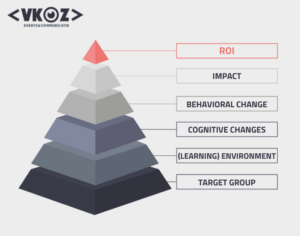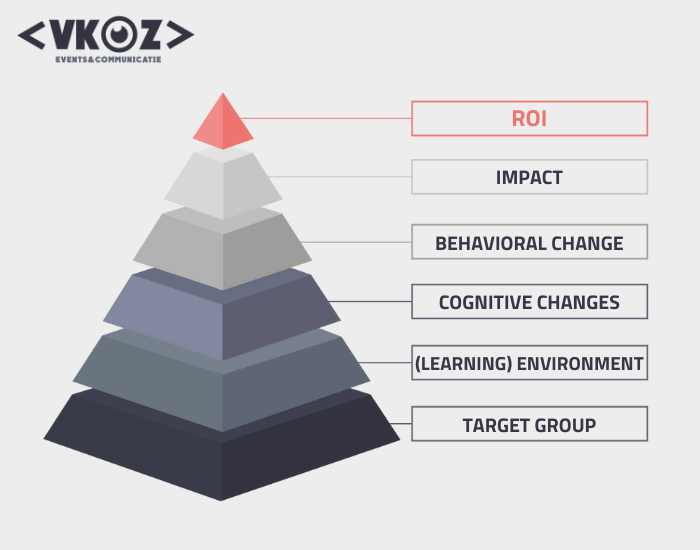An event is a powerful tool to convey your communication message. But organizing a successful event is also a major investment: how do you make your event profitable? To achieve this, it is important to work from one or more objectives and then measure them to ultimately calculate your Return on Investment (ROI). You do this with these 7 steps.
Step 1: Determine your goal
At the end of the day, your event should yield a plus. You should ask yourself the following questions: what is the problem or opportunity that I want to achieve with this event? What activities are needed to achieve the objective and how does it fit into our marketing mix? Objectives can be:
- sharing knowledge or information
- improving internal or external relations
- motivating or rewarding
- improving brand awareness or image building
- profit motive or fundraising
DON’T: Organizing an event without an objective. That is wasted money.
Step 2: Determine what the desired effect is for your guests
What should your guests do after the event? The real value of an event lies in the actions your visitors will take after the event, or even during your event. Even the behavior before an event can be influenced, just think of an incentive. It is not enough that they only think or feel, it is also about doing. The question that will help you with this is: Why aren’t they doing that already?
Step 3: Determine what the learning experience at the event should be
How are your guests going to do what you described in step 2? Effective learning is learning through experiences, with all five senses that need to be stimulated. What do they need to learn/experience at the event to change their behavior? At the event you will receive information, but if this is live, your guest will experience this with other guests, which creates trust. You change the attitude of the visitor towards your brand with a learning experience.
Step 4: Create an environment where your guest can learn through experience
The learning experience of a live event cannot be separated from the environment in which it has to take place. Research shows that elements such as light, music, color and catering influence learning during an experience such as an event. For example, it has been shown that the concept and the decoration of a presentation have more impact than the actual content. In short, ensure a learning environment with impact.
DO: Inspire, create, innovate and profit. Develop a surprising, varied and interactive program for your online event to achieve the greatest possible
impact.
Step 5: Measure satisfaction and planned actions
After the event, it’s time to measure. Start with the basics and evaluate the learning environment. Did the event meet expectations? Can guests use what they learned? What do guests expect to do differently after attending the event? If they didn’t plan any action, the event was worthless. Measure this immediately after the event.
Step 6: Measure what was learned and how their behavior changed
What did the participants learn? How did their behavior change as a result? In many cases, it is sufficient to simply ask what the guest remembered from the information you conveyed at the event. Did their attitude toward your brand change? Did they create meaningful networks with other participants? Measuring this 2 to 4 months after the event is recommended.
TIP: When measuring your Return on Investment, also consider: the reach on social media, the number of visitors to the website, the use and search for information via an event app, the number of new customers or extra sales and of course the survey. Read here four ways in which you can ask for feedback from your participants.
Step 7: The business impact: ROI
The ultimate business impact is the result of human actions. For consumer events, this often translates into sales. For internal events, for example, it is about cost reduction through greater effectiveness. But whatever event or goal you measure, make sure you find out as much as possible whether the effect is the cause of the event visit. Finally, translate the business impact into euros to finally measure a real ROI: impact in euros – the costs of the event: divided by the costs = your return on event.
VKOZ uses the ROI pyramid method
With the method of Dr. Elling Hamso you determine the effectiveness of events. This means that we set clear goals in advance for 6 consecutive levels: ROI, impact, behavioral change, cognitive change, (learning) environment and target group. What should your event achieve or bring about at each of these levels? After the event we use the VKOZ measuring stick to measure which results have been achieved at each level. Want to know more? Contact us for a free consultation.
VKOZ focuses on your objectives and thinks from the needs of your visitors.
Want to know more about calculating the ROI of your event or would you like other tips for organizing an event? VKOZ events & communications is happy to think along with you. Call 010-2107961 or send an email with your question to info@vkoz.nl.
Source: evenementorganiseren.nl

